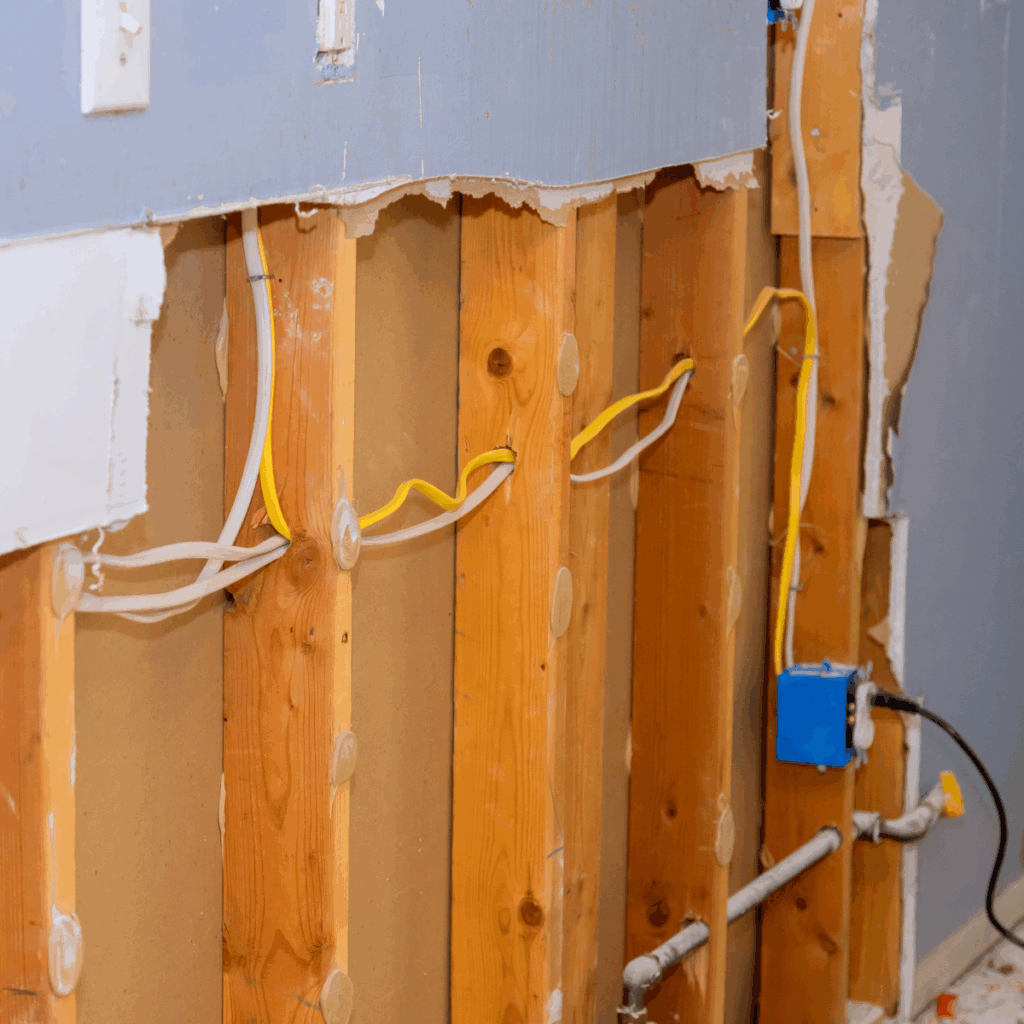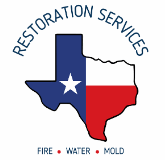From flooding to pipe bursts to slow plumbing leaks, water damage occurs in homes for a variety of reasons.
While some of them come on fast and others are acts of nature, there’s one thing that remains true about any type of water damage: It needs to be fixed by a professional, and fixed fast.
Especially for us living in Houston, damage from water issues can create a host of issues for our homes. When water goes in a building where it doesn’t belong, it can be the source of mold growth, which can lead to significant health issues and further damage to our air and structure of our homes.

In this guide, we’ll cover everything you need to know from detecting water damage in your home, to how you can create a plan to fix the issues and what you can do to prevent any further damage from happening. Key topics include:
Key Sources of Water Damage
Wherever there may be a water connection within your home, there could potentially be damage from water there – and beyond.
Because insurance policies cover most types of waterissues that come from within the home, it’s important to look at the water damage in terms of the sources they identify.

Category 1: Clean Water
This includes water from a clean source that won’t cause any immediate illness or ill effects. This may include overflows from a sink or bathtub, or a broken water supply line with clean water.

Category 2: Gray Water
This water tends to cause illness because it has bacteria or other dangerous microorganisms. Gray water may be from issues with a washing machine or dishwasher, or a toilet that overflows with urine in it.
Clean water that has flowed through building materials (from the second floor down to the first, or from the attic insulation into a living space) or clean water that has been sitting for an extended period (24-48 hours) can become gray water if there is growth of bacteria or microorganisms in it.

Category 3: Black Water
From a sewage backup, to floodwaters, to toilet overflows with fecal matter, black water is the most dangerous category. It is highly contaminated and could cause illness or death. This could also include contaminated groundwater or gray water that has not been treated for more than 48 hours.

Which Category is My Water Damage?
Sometimes, homeowners don’t know which category their water issue falls into. This is why it’s important to contact a certified professional as soon as you discover the water damage. They can come out immediately to assess the situation and determine the category, as well as appropriate next steps.
How to Identify Water Damage
Identifying where you have damage from water issues can be challenging, especially if it’s happening in areas that you can’t visibly see like behind the walls or under your flooring. There are some signs that you can look out for to know if there is water damage in your home.
Discoloration & Stains: As water leaks and dries, it will leave behind mineral deposits. These mineral deposits will create stains and other discolorations on your ceilings, walls, and even flooring. If you see brown, yellow, or dark spots, this could be an indication of water damage.
Peeling or Bubbling Paint/Wallpaper: If you see bubbles in your paint or wallpaper on your walls, it’s a sign that you should assess for any water damage. Moisture trapped behind a surface, like between the wall and paint or wallpaper, will weaken the paint or adhesive. This will make it bubble, crack, or even start to peel it away from the wall.
Changes to Hard Surfaces: Beyond damage to paint or wallpaper, other signs may appear that could indicate water damage. This could include spongy drywall. Wood cabinets or floors may warp, swell, or even buckle. The ceiling may sag. If you see these changes but aren’t sure of what’s causing them, a certified professional can assess the situation quickly and advise next steps.
Unexplained Water: Seeing little puddles of water, small wet spots, or even water dripping down your walls serves as the most obvious sign that there may be water damage. You may find these in various places in your home, including on the floor, under a sink, or by a water heater or near your HVAC drain line.
Water Sounds: If you hear water sounds that aren’t coming from your sound machine, or any faucets or appliances, it could be an indication that there’s water creating damage. Following the sound can help you identify where it may be happening. In some cases, you may not be able to pinpoint it. Regardless, a certified professional can quickly assess the situation
The Hidden Dangers of Water Damage
Damage from water can be frustrating and upsetting to detect, especially when it’s something that has been building over time. However, water damage can cause some significant issues to your home.

Mold Damage
Within 24-48 hours of water damage, mold starts to grow. Mold can cause issues with air quality. It can also cause structural and physical damage where it grows.

Pest Infestation
The wet and moist conditions can also attract pests, including ants, rodents, and even termites. These can cause significant problems if given the chance.

Structural Problems
From wood beams to drywall and insulation, water damage can hurt your home’s structural integrity over time. A professional will identify if the water damage has extended to the home’s structure.

Electrical Hazards
Standing or leaking water could create electrical hazards if it comes in contact with electrical wiring. This is why it’s important to contact a professional as soon as you detect any damage to assess the full situation.

What to Know About Insurance
Most water issues may be covered by your homeowner policy. If you detect water damage, there are some key things you should know to ensure that you are getting the payout you deserve for your water-related damage claims. According to your insurance policy, it may be called your “duty” to help mitigate any further damage.
The key actions you need to take include:
- Know your deductible and limit for claims for damage from water
- Have a professional assess the damage to determine the severity
- Take immediate action to prevent further damage, like using dehumidifiers and removing water with a professional’s help (often called emergency stabilization services)
- Identify how it happened – and communicate with your hired professional so it’s included in the claim to the insurance company
- Understand the type of damage that can happen from water
- Follow the process identified by the insurance company, including how to open the claim, appraise the property, and submit ongoing documentation
Preventing Future Water Issues From Happening
Focusing on water damage mitigation – or what you can do to prevent future issues from happening – starts with looking at a few things around your home to make sure that everything works as expected.
For instance, look at your plumbing and appliances that use water on a regular basis. Key areas to look include:
- Under sinks
- Around toilets
- Behind the fridge
- Around your line for the fridge’s ice maker
- Under the dishwasher
- Near your HVAC drain line
- Around your hot water heater
- By your washing machine water lines
Make sure the hoses are working properly and there are not any cracks or kinks, which could lead to issues. If you do see any leaks or damage – no matter how small – address immediately by contacting a certified professional.
In Houston, we get a lot of rain – which can mean that your gutters are working overtime. If your gutters are backing up, it could damage your roof or even your exterior walls, which can lead to internal damage. Keep an eye on your gutters to ensure they are working properly and ready for whatever the next storm will bring.
While it won’t help to prevent a current issue, knowing the location of your water shut-off valve will ensure you can turn it off quickly in the event of an emergency.
In doing so, you can turn what could be a huge problem into something that is much more minor and easier to fix.
And, make sure to look at your foundation on a regular basis so that there aren’t rainwater puddles collecting. The ground near your home should slope away from the foundation to keep rain and other water away from your home.
While it won’t help to prevent a current issue, knowing the location of your water shut-off valve will ensure you can turn it off quickly in the event of an emergency. In doing so, you can turn what could be a huge problem into something that is much more minor and easier to fix.
How to Select the Right Professional to Fix Water Damage
When it comes to fixing damage, it’s more than finding a certified professional that can restore the damage and remove any lingering issues from the water.
It’s important to work with someone who has worked with insurance companies in the past to submit and manage claims for water issues. In Texas in 2024, nearly half of homeowner claims for insurance reimbursement resulted in the owner receiving no money for the damage. This is why it’s essential that the professional you choose has experience working with insurance companies.
In doing so, you can ensure the professional follows the preferred process of submitting information, informing the insurance company of status updates, and working with the insurance company on getting an appraisal and cost estimate.
In addition, there are key certifications to look for when selecting a professional that is experienced in fixing issues from water. See if the chosen professional has a certification in water damage restoration.
Spending some time initially to select a professional that has the right experience and qualifications can save you headaches and time later.
Looking for someone to help with water damage detection, remediation, or mitigation? Get in touch with a certified technician that specializes in repairing this type of damage in Houston.
Learn About Water Damage Restoration Near You
TX Restoration Services provides educational information and resources to residents in many Houston cities.
Learn more about mold mitigation in your specific area:
